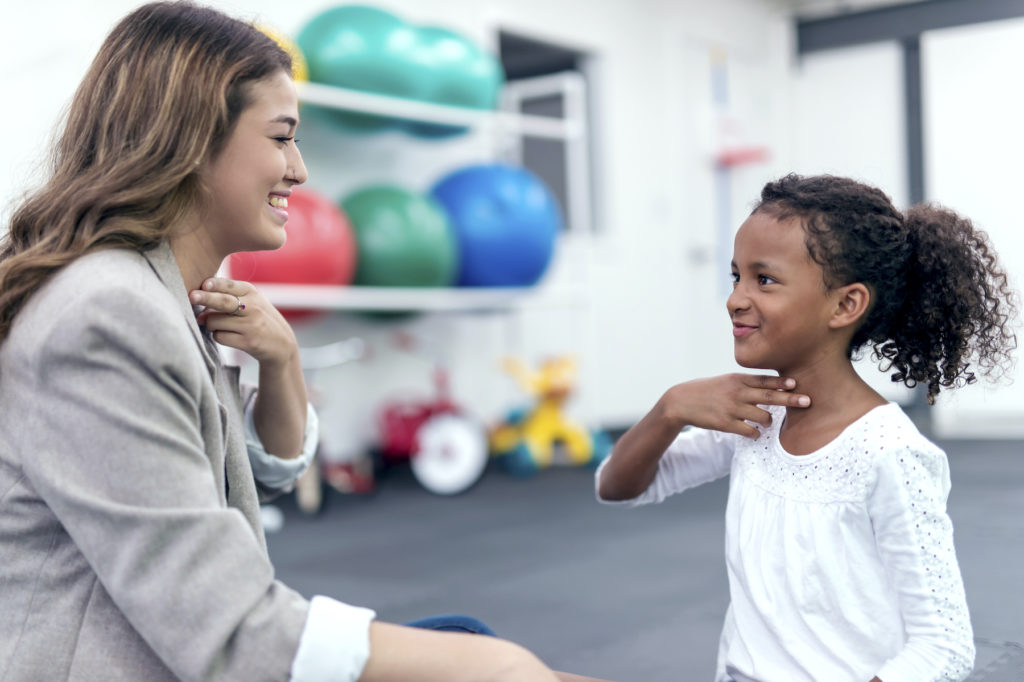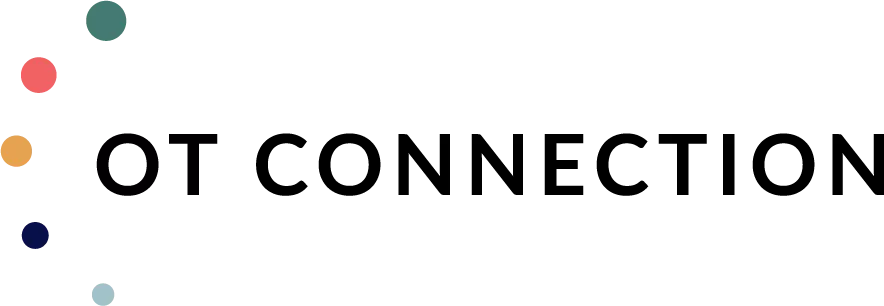Our Services ——
Providing Care for All of Your Pediatric Therapy Needs
Speech Therapy
At OT Connection, Speech and Language Therapy for children includes intervention programs for the treatment of speech, language, fluency, feeding, and pragmatic/social disorders. Our staff meets with the child, as well as parents, family members and other involved care-givers in order to assess each child’s strengths and areas of concern, set realistic goals and objectives, and plan for therapy.
At OT Connection, our therapists create an individualized therapy program and unique treatment approach for each child. Our highly trained staff implements a variety of evidence-based strategies throughout their Speech Therapy sessions and can adapt their sessions based on the strengths and areas of challenge for each client. Our clinic offers a warm, playful, family oriented environment. Common areas of delay we treat and services we offer include:
Our Expertise:
Experience working with patients diagnosed with but not limited to:
- Autism Spectrum Disorder (ASD)
- Expressive and Receptive Language Disorders
- Articulation Disorder
- Phonological Processing Disorder
- Childhood Apraxia of Speech (CAS)
- Dysphagia/oral aversions
- Dyslexia
- Cerebral Palsy
- Fluency Disorders (Stuttering and Cluttering)
- Pragmatic Language Disorders
- Aphasia
- Traumatic Brain Injuries
- Sensory Integration Disorders (related to speech and feeding)
- Cleft Palate
- ADHD
- Intellectual Disabilities
- Auditory Processing Disorder
- Learning Disabilities
- Maladaptive Behaviors
- Hearing Impairments
Therapy Focused Activities and Techniques Including:
- Free Speech and Language Screenings
- Early Childhood Intervention
- Use of American Sign Language (ASL)
- Augmentative Alternative Communication (AAC)
- Picture Exchange Communication System (PECS)
- Implementation of Nancy Kaufman’s, Kaufman Apraxia System
- Implementation of Michelle Garcia Winner’s Social Thinking Concepts
- Activities of Daily Living (ADL)
- Auditory Memory Intervention
- Play-Based Therapy
- Co-treating sessions with OT and PT available to address sensory and motor needs in conjunction with speech therapy difficulties
- PROMPT
- Consultation for Social Skills and Play Groups
- Phonemic Awareness Activities
- Beckman Oral Motor exercises
- Talk Tools

Commonly used speech-language therapy terms:
(Adapted from Terminology of Communication Disorders, 4th Edition by Lucille Nicolosi, Elizabeth Harryman and Janet Kresheck)
Ankyloglossia – limited movement of the tongue due to abnormal shortness of the lingual frenum; commonly referred to as tongue-tie.
Apraxia – a disorder of articulation characterized by impaired capacity to program the position of speech musculature and the sequencing of muscle movements for the production of speech. Also referred to as dyspraxia.
Article – noun modifier that denotes specificity; e.g. a, an, the.
Articulation – the way phonemes are formed in speech. Articulation disorder – incorrect production of speech sounds due to faulty placement, timing, direction, pressure, speed or integration of the movement of the lips, tongue, velum (soft palate).
Articulators – organs of the speech mechanism which produce meaningful sound (i.e., lips, lower jaw, velum, tongue and pharynx).
Audition – the sense or act of hearing.
Auditory processing – the ability to fully utilize what is heard.
Auditory processing disorder – impaired ability to attend, discriminate, recognize or comprehend auditory information even though hearing and intelligence are within normal limits.
Augmentative and alternative communication (AAC) – any approach designed to support, enhance or supplement the communication of individuals who are not independent verbal communicators.
Babbling – verbal conduct of infants during the second half of the first year of life.
Barium swallow study – the use of videofluoroscopy to evaluate the pharyngeal swallow.
Bilabial – pertaining to the two lips.
Bilingual – ability to utilize two languages with equal facility.
Bite – the forcible closure of the lower teeth against the upper teeth; to seize or grasp with the teeth.
Mature – the teeth close easily on the food, biting through it gradually.
Phasic – a rhythmical bite and release pattern seen as a series of jaw openings and closings occurring when the gums or teeth are stimulated. Present at birth and continues until 3 to 5 months of age in the typical infant.
Block – in stuttering, the stoppage or obstruction at one or several locations – larynx, lips, tongue, etc.- experienced by the stutterer when trying to talk which temporarily prevents smooth sound production.
Bolus – the rounded mass of food prepared by the mouth for swallowing (after chewing).
Carryover – in speech, the habitual use of newly learned speech or language techniques in everyday situations (outside of therapy).
Cause-Effect – performing one behavior in order to achieve a further objective, e.g. hitting a switch to activate a toy.
Cueing – a function to assist or obtain a desired response, e.g. giving the command “Sit in the chair” while pointing to the chair.
Deglutition – the act of swallowing.
Dentition – natural teeth, considered collectively, in the dental arch.
Dental arch – curved structure formed by the teeth in their normal position.
Deviation – in statistics, the amount by which a measure differs from a point of reference, generally from the mean.
Diadochokinesis – in speech, the ability to execute rapid repetitive movements of the articulators.
Diadochokinetic rate – the speed with which one can perform contrasting (or repetitive) movements, as in saying the following syllables: puh-tuh-kuh.
Dysarthria – term for a collection of motor speech disorders due to impairment originating in the central or peripheral nervous system. Respiration, articulation, phonation, resonation, and/or prosody may be affected.
Dysfluency – any type of speech which is marked with repetitions, prolongations and hesitations; an interruption in the flow of speech sounds. Commonly known as stuttering.
Echolalia – tendency for an individual to repeat without modification that which is spoken to him; normally occurs between 18 and 24 months of age.
Delayed – repetition of an original utterance at some later time. Immediate – instant repetition of the original utterance.
Mitigated – repetition of the original utterance with slight modification.
Unmitigated – unchanged repetition; exact duplication of the original utterance.
Elicit – to draw forth or bring out.
Epenthesis – the insertion of an additional phoneme in a word or in a group of sound, e.g. tree becomes taree.
Eye contact – “looking him/her in the eye” while talking to the listener; generally a natural, although not a constant, interaction of the speaker’s eyes with those of the listener.
Fluency – smoothness with which sounds, syllables, words and phrases are joined together during oral language; lack of hesitations or repetitions in speaking.
Frenulum – a small frenum.
Frenum – small cord of tissue extending from the floor of the mouth to the midline of the inferior surface of the tongue blade; important in speech because if too short it may restrict the elevation and extension of the tongue.
AbAdaptive Response: An action that is appropriate and successful in meeting some environmental demand.Adaptive responses demonstrate adequate sensory integration and drive all learning and social interactions.
Auditory: Language processing skills: the abilities of listening and verbally communicating, acquired as onhears and perceives sounds and interacts with the environment.
Auditory Perception: The ability to receive, identify, discriminate, understand and respond to sounds.
Bilateral Coordination: The ability to use both sides of the body together in a smooth, simultaneous, andcoordinated manner.
Bilateral Integration: The neurological process of integrating sensations from both body sides; the foundation for bilateral coordination.
Binocularity (Binocular Vision; Eye Teaming): Forming a single visual image from two images that the eyes separately record.
Body Awareness: The mental picture of one’s own body parts, where they are, how they interrelate, and how they move.
Cocontraction: All muscle groups surrounding a joint contracting and “working” together to provide that joint stability resulting in the ability to maintain a position.
Depth Perception: The ability to see objects in three dimensions and to judge relative distances between objects, or between oneself and objects.
Directionality: The awareness of right/left, forward/back, and up/down, and the ability to move oneself in those directions.
Discriminative System: The component of a sensory system that allows one to distinguish differences among stimuli. This system is not innate but develops with time and practice.
Dyspraxia: Deficient motor planning that is often related to a decrease in sensory processing.
Eye-Hand Coordination: The efficient teamwork of the eyes and hands, necessary for activities such as playing with toys, dressing, and writing.
Equilibrium: A term used to mean balance.
Extension: A straightening action of a joint (neck, back, arms, legs).
Fight-Or-Flight Response: The instinctive reaction to defend oneself from real or perceived danger by becoming aggressive or by withdrawing.
Figure-Ground Perception: The ability to perceive a figure in the foreground from a rival background.
Fine Motor: Referring to movement of the muscles in the fingers, toes, eyes and tongue.
Fine Motor Skills: The skilled use of one’s hands. It is the ability to move the hands and fingers in a smooth, precise and controlled manner. Fine motor control is essential for efficient handling of classroom tools and materials. It may also be referred to as dexterity.
Fixation: Aiming one’s eye at an object or shifting one’s gaze from one object to another.
Flexion: A bending action of a joint or a pulling in of a body part.
Focusing: Accommodating one’s vision smoothly between near and distant objects.
Form Constancy: Recognition of a shape regardless of its size, position, or texture.
AbAdaptive Response: An action that is appropriate and successful in meeting some environmental demand.Adaptive responses demonstrate adequate sensory integration and drive all learning and social interactions.
Auditory: Language processing skills: the abilities of listening and verbally communicating, acquired as onhears and perceives sounds and interacts with the environment.
Auditory Perception: The ability to receive, identify, discriminate, understand and respond to sounds.
Bilateral Coordination: The ability to use both sides of the body together in a smooth, simultaneous, andcoordinated manner.
Bilateral Integration: The neurological process of integrating sensations from both body sides; the foundation for bilateral coordination.
Binocularity (Binocular Vision; Eye Teaming): Forming a single visual image from two images that the eyes separately record.
Body Awareness: The mental picture of one’s own body parts, where they are, how they interrelate, and how they move.
Cocontraction: All muscle groups surrounding a joint contracting and “working” together to provide that joint stability resulting in the ability to maintain a position.
Depth Perception: The ability to see objects in three dimensions and to judge relative distances between objects, or between oneself and objects.
Directionality: The awareness of right/left, forward/back, and up/down, and the ability to move oneself in those directions.
Discriminative System: The component of a sensory system that allows one to distinguish differences among stimuli. This system is not innate but develops with time and practice.
Dyspraxia: Deficient motor planning that is often related to a decrease in sensory processing.
Eye-Hand Coordination: The efficient teamwork of the eyes and hands, necessary for activities such as playing with toys, dressing, and writing.
Equilibrium: A term used to mean balance.
Extension: A straightening action of a joint (neck, back, arms, legs).
Fight-Or-Flight Response: The instinctive reaction to defend oneself from real or perceived danger by becoming aggressive or by withdrawing.
Figure-Ground Perception: The ability to perceive a figure in the foreground from a rival background.
Fine Motor: Referring to movement of the muscles in the fingers, toes, eyes and tongue.
Fine Motor Skills: The skilled use of one’s hands. It is the ability to move the hands and fingers in a smooth, precise and controlled manner. Fine motor control is essential for efficient handling of classroom tools and materials. It may also be referred to as dexterity.
Fixation: Aiming one’s eye at an object or shifting one’s gaze from one object to another.
Flexion: A bending action of a joint or a pulling in of a body part.
Focusing: Accommodating one’s vision smoothly between near and distant objects.
Form Constancy: Recognition of a shape regardless of its size, position, or texture.

